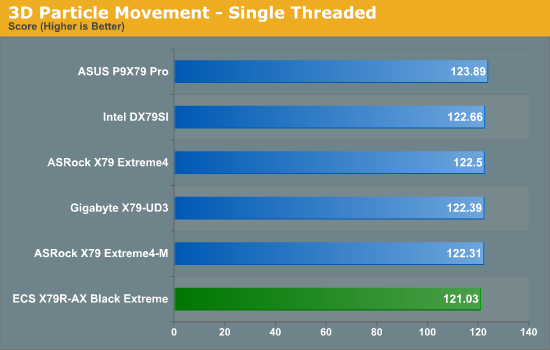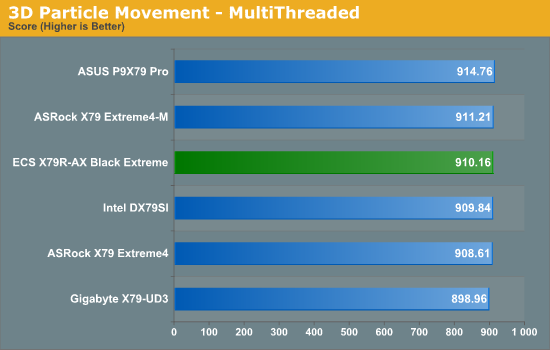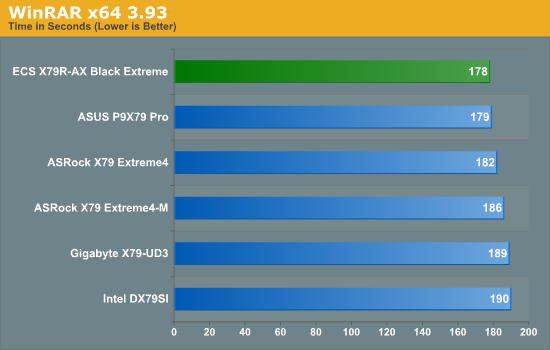ECS X79R-AX (Black Extreme) Review
by Ian Cutress on January 13, 2012 12:30 PM EST- Posted in
- Motherboards
- ECS
- X79
3D Movement Algorithm Test
The algorithms in 3DPM employ both uniform random number generation or normal distribution random number generation, and vary in various amounts of trigonometric operations, conditional statements, generation and rejection, fused operations, etc. The benchmark runs through six algorithms for a specified number of particles and steps, and calculates the speed of each algorithm, then sums them all for a final score. This is an example of a real world situation that a computational scientist may find themselves in, rather than a pure synthetic benchmark. The benchmark is also parallel between particles simulated, and we test the single thread performance as well as the multi-threaded performance.


The single thread performance seems a little low (as echoed in the other ST tests), but the multi-thread result is on par with competitors.
WinRAR x64 3.93 - link
With 64-bit WinRAR, we compress the set of files used in the USB speed tests. WinRAR x64 3.93 attempts to use multithreading when possible.

The ECS board takes the record in our multi-threaded WinRAR test!
FastStone Image Viewer 4.2 - link
FastStone Image Viewer is a free piece of software I have been using for quite a few years now. It allows quick viewing of flat images, as well as resizing, changing color depth, adding simple text or simple filters. It also has a bulk image conversion tool, which we use here. The software currently operates only in single-thread mode, which should change in later versions of the software. For this test, we convert a series of 170 files, of various resolutions, dimensions and types (of a total size of 163MB), all to the .gif format of 640x480 dimensions.

Reflecting the 3DPM benchmark result, the ECS board seems not to perform as well in single threaded applications.
Sorenson Squeeze 6.0 - link
Sorenson Squeeze is a professional video encoder, complete with a vast array of options. For this test, we convert 32 HD videos, each a minute long and approximately 42 MB in size, to WMV 512KBps format. Squeeze can encode multiple videos at once, one for each thread.

However again the ECS board performs well in multi-threaded mode, coming top of our tested boards.










36 Comments
View All Comments
theangryintern - Monday, January 16, 2012 - link
I fell victim to their low prices a few times, and every time it was a complete crap product. I've had a few friends that have had nothing but trouble with their products as well. Definitely one company I will stay way away from and I never recommend their products to anyone I know.darwiniandude - Sunday, January 15, 2012 - link
I built an 'el cheapo box in late 2001 based around an ECS K7S5A motherboard, SiS chipset, AMD cpu, it was the cheapest of the cheap at the time. Was mostly used as an office machine, but it's never had any hardware replaced until I replaced it with something good a few months ago. Was mostly on 24/7.Obviously, I'm sure this the exception rather than the rule, but I was still pretty impressed.
LoneWolf15 - Sunday, January 15, 2012 - link
The K7S5A wasn't a bad board --provided you got a good one. The design was fair --the quality control, like many other ECS products, was all over the map.I'm sure ECS can design an okay board, should they choose to do so. However, one segment of their production is cut-rate low-cost boards (which does nothing to inspire confidence) and if you combine that with inconsistent quality control, I don't trust their top-end stuff based on the other things they make.
MSI, Gigabyte, and others have much higher consistency in quality control even in their value $70-100 mainboards.
JediJeb - Sunday, January 15, 2012 - link
I am currently using one of the ECS L7S7A2 motherboard, matter of fact posting from it right now. It isn't and extreme overclocker but I have been running my AthlonXP2400M overclocked from 1.8ghz to 2.3ghz for the last 6 years or so 24/7. Before that I was using an ECS K7S5A which ran for several years overclocked until it was hit by lightening and popped one of the MOSFETs. I guess I have been one of the lucky ones to get two good boards in a row.DanNeely - Monday, January 16, 2012 - link
What a lot of people nursing grudges from a decade+ back fail to acknowledge is that when the number of board makers consolidated heavily in the early part of the last decade that the surviving companies with bad engineering reps were able to gobble entire design teams from companies that produced quality products but didn't have enough volume to sustain themselves in the market with the result that even the budget brands now have decent hardware quality.Nfarce - Monday, January 16, 2012 - link
Glad I'm not the only one who thinks ECS is crap. Made the mistake of buying one at Fry's several years ago for a buddy's E8400 build. Worst mobo I've ever bought since my first build during the Pentium II days. ECS has always been the cheap mobo, and the very idea of them coming off with a $300+ X79 is laughable. Fool me once, shame on me...popej - Friday, January 13, 2012 - link
This could work at office PC, but i doubt if enthusiasts would buy motherboard with no expansion capability.MrTeal - Friday, January 13, 2012 - link
Maybe not, but even for most enthusiasts 16GB shows little or no benefit over 8GB. By the time the you start wanting 32GB you'll probably be wanting Haswell-E or 32GB of DDR4 anyway.Nihility - Friday, January 13, 2012 - link
I disagree.My PC almost always uses 7.5 GB out of the available 8 GB. And I have to constantly close programs to make sure my system doesn't begin swapping.
Maybe 12 is enough, but 8 is not enough.
cjl - Friday, January 13, 2012 - link
What on earth are you doing where that much memory is in constant use? Either you have an enormous memory leak in several programs, or you are a very atypical user.That having been said, I would say that a SNB-E system should be built with at least 16GB (4x4GB), since 4GB RAM sticks aren't that expensive these days. A case could even be made for 32GB (4x8GB), since even 8GB sticks aren't that bad, and SNB-E is likely to be used primarily by pretty heavy users anyways.